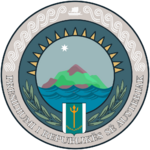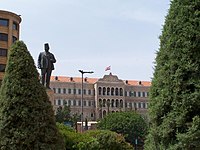Presidium of Austeria: Difference between revisions
mNo edit summary |
mNo edit summary |
||
| Line 50: | Line 50: | ||
| motto = | | motto = | ||
}} | }} | ||
The '''Presidium of the Austerian Republic''', commonly known as the '''Presidium of Austeria''', is the highest {{wp|Executive (government)|executive body}} of the federal government of [[Austeria]]. It is a 21-member body, lead by the [[President of Austeria | The '''Presidium of the Austerian Republic''', commonly known as the '''Presidium of Austeria''', is constitutionally the highest {{wp|Executive (government)|executive body}} of the federal government of [[Austeria]]. It is a 21-member body, lead by the [[President of Austeria]], elected to a four-year term in a nationwide multi-member constituency apportioned among Austeria's religious groups. The body was established under the [[1988 Consitution]] of the [[Austerian People's Republic]] and remained after the formation of the current Austerian Republic. | ||
The Presidium serves as the collective {{wp|head of state}} and {{wp|head of government}} of Austeria. The Presidium is chaired by the [[President of Austeria]], officially the Chairperson of the Presidium, and exercises overall leadership of its work. The [[Deputy President of Austeria]], formally known as the Deputy Chairperson, serves as vice-chair and is responsible for handling the daily work at the direction of the President. Despite their offices, they exercise no particular authority and serve as {{wp|Primus inter pares|first among equals}}. | |||
The Presidium collectively exercises the federal executive’s powers such as approving declarations of war and the signing international treaties. The body leads the administration of the federal government through its oversight of the State Council, the {{wp|cabinet (government)|cabinet}} of the country; the [[Premier of Austeria]]; and government agencies. The body collectively wields some legislative powers such the authority to {{wp|veto}} bills from the [[Senate of Austeria]] and drafting certain types of legislation. The Presidium makes decisions either by {{wp|Consensus decision-making|consensus}}, or when consensus is not possible, by a two-thirds majority. | |||
Revision as of 07:45, 18 February 2024
Presidium of the Austerian Republic Presidiumi i Republikës së Austrisë | |
|---|---|
| 8th Presidium | |
 | |
| Type | |
| Type | |
| History | |
| Founded | 14 August 1988 |
| Preceded by | Presidium of the National Congress |
| Leadership | |
| Structure | |
| Seats | 21 |
 | |
Political groups | |
| Elections | |
| Plurality block voting with seats allocated by religion | |
Last election | 25 June 2020 |
| Meeting place | |
 | |
| Presidium building in Kartha | |
The Presidium of the Austerian Republic, commonly known as the Presidium of Austeria, is constitutionally the highest executive body of the federal government of Austeria. It is a 21-member body, lead by the President of Austeria, elected to a four-year term in a nationwide multi-member constituency apportioned among Austeria's religious groups. The body was established under the 1988 Consitution of the Austerian People's Republic and remained after the formation of the current Austerian Republic.
The Presidium serves as the collective head of state and head of government of Austeria. The Presidium is chaired by the President of Austeria, officially the Chairperson of the Presidium, and exercises overall leadership of its work. The Deputy President of Austeria, formally known as the Deputy Chairperson, serves as vice-chair and is responsible for handling the daily work at the direction of the President. Despite their offices, they exercise no particular authority and serve as first among equals.
The Presidium collectively exercises the federal executive’s powers such as approving declarations of war and the signing international treaties. The body leads the administration of the federal government through its oversight of the State Council, the cabinet of the country; the Premier of Austeria; and government agencies. The body collectively wields some legislative powers such the authority to veto bills from the Senate of Austeria and drafting certain types of legislation. The Presidium makes decisions either by consensus, or when consensus is not possible, by a two-thirds majority.